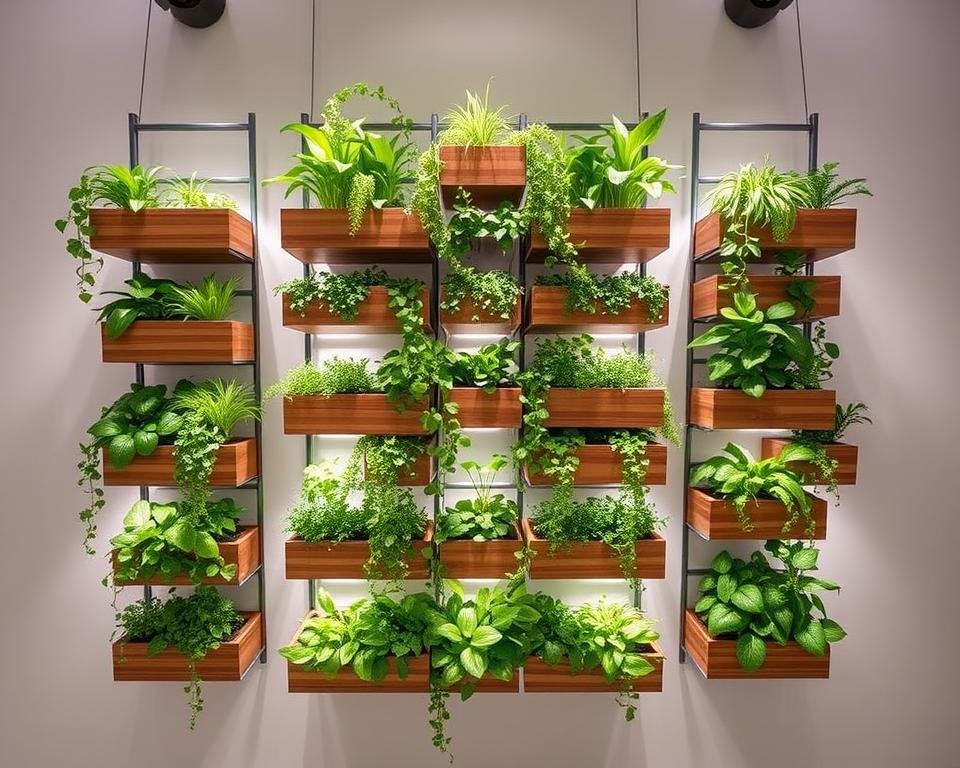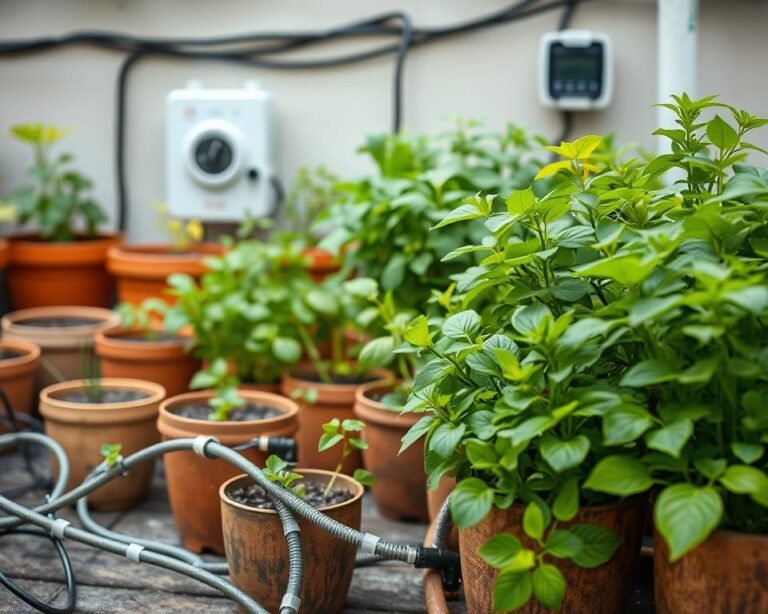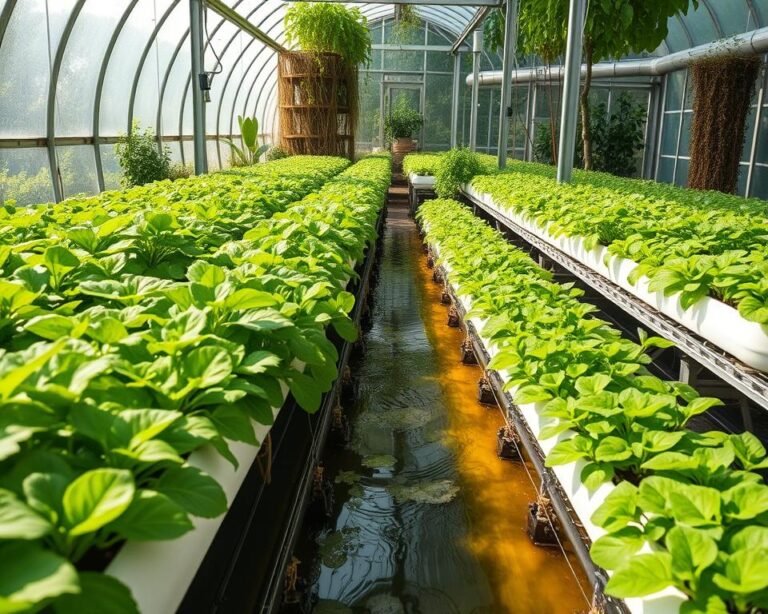Modular Designs for Space‑Saving Vertical Gardens
Ever feel limited by a lack of room to garden? With smart modular designs, you can transform any city dwelling into a thriving green oasis. Modular vertical gardens stack upward, multiplying planting space and adapting perfectly to apartments, offices, and even large commercial sites.
These flexible systems offer more than visual appeal—they can produce up to ten times more food than traditional plots by using vertical space efficiently. Best of all, modular designs grow with you: start with a single panel and expand as your skills and ambitions do. No matter your square footage or experience level, modular vertical gardens make urban gardening easy, scalable, and endlessly creative.t in small apartments or big commercial spaces, offering endless options.
Key Takeaways
- Maximize limited space with innovative vertical garden designs
- Increase food production in compact urban environments
- Create customizable green spaces tailored to your needs
- Enjoy higher yields with space-efficient gardening solutions
- Transform urban living with adaptable and flexible garden systems
Understanding the Rise of Vertical Garden Systems
Vertical garden systems are changing urban spaces. They are new ways to grow food and live green. These systems are making cities greener and more efficient.
Urban areas struggle to find space for gardens. Vertical gardens solve this problem. They turn small spots into green areas. This is a big step towards sustainable living.
Space-Saving Benefits for Urban Environments
Vertical gardens offer amazing benefits. Here are some key facts:
- They can grow up to 10 times more produce than regular gardens
- Support 40-50 plants in just 4 square feet
- Hydroponic towers can grow 50 plants in one square foot
Transforming Limited Spaces into Green Oases
Modern vertical gardens do more than grow plants. They make cities healthier and look better. They can clean the air and cool down the city.
Economic Advantages of Vertical Growing
Vertical gardens also save money:
- Use 30-50% less water with smart irrigation
- Use 30% less energy with AI climate control
- Keep plants healthy and grow more food
By using vertical gardens, you’re not just growing plants. You’re making cities better and more sustainable. It’s a new way to live in harmony with nature.
Smart Technology Integration in Modern Garden Designs
Vertical gardens are getting a tech boost, changing how we grow plants in tight spots. Now, with advanced plug-and-play designs, gardeners can control entire gardens with smart tech. This tech helps plants grow better and uses resources wisely.
Today’s vertical gardens use the latest tech to make gardening easier and more fun. You can change your garden’s setup easily with new parts. Smart sensors and AI help control things like soil moisture and climate.
- Monitor soil moisture levels in real-time
- Automatically adjust irrigation schedules
- Optimize nutrient delivery
- Control environmental conditions
These systems can cut down energy use by 30% and boost plant growth. You can even check on your garden from your phone. Imagine controlling your garden’s climate and nutrition with just a few taps on your phone!
“Technology is turning vertical gardening from a hobby into a precise, data-driven experience.” – Urban Gardening Quarterly
Smart tech lets your garden adjust to changes on its own. It handles water and nutrients automatically. This makes city gardening easier and more successful than ever.
Modular Designs: Customizable Components and Structures
Vertical gardening has changed urban growing with reconfigurable systems. These designs make growing plants easy in any space.
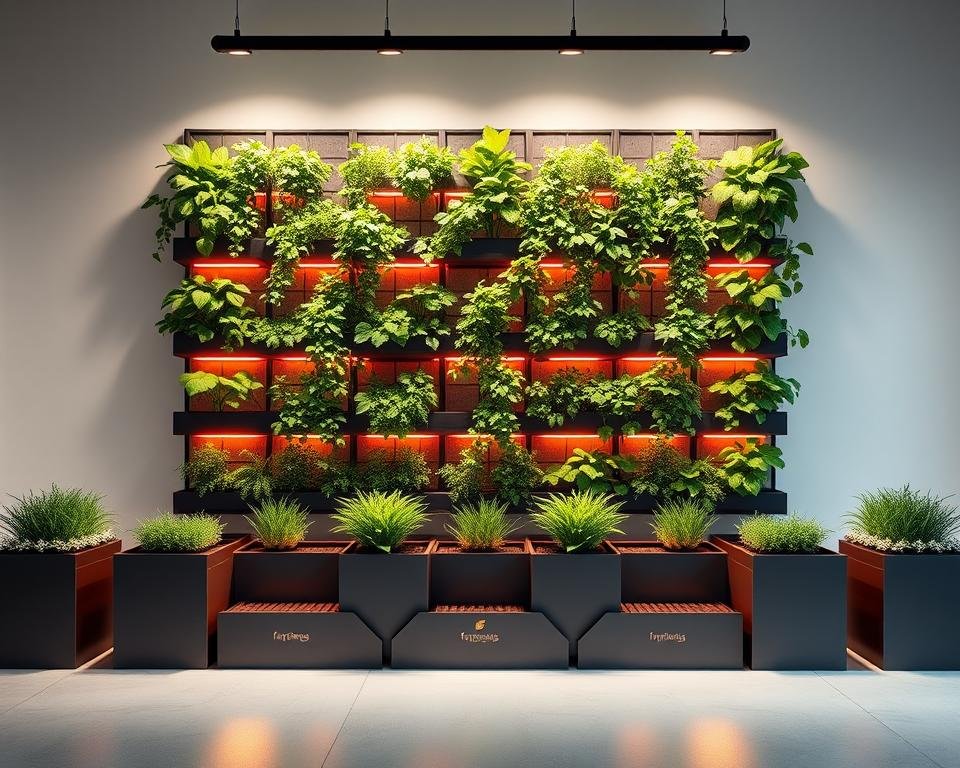
Modular construction makes vertical gardens very adaptable. Your garden can grow and change as your needs do. It can hold up to 40-50 plants in just 4 square feet.
Stackable and Expandable Systems
Flexible manufacturing creates dynamic gardens. You can start small and grow your garden as you want. These systems are designed to:
- Easily stack additional growing modules
- Connect multiple units seamlessly
- Adapt to different room configurations
Interchangeable Parts for Maximum Flexibility
Modern vertical garden designs have parts that can be swapped or rearranged. Imagine a garden that transforms as easily as your living space. These systems let you:
- Replace damaged plant modules quickly
- Adjust irrigation systems with minimal effort
- Customize your garden’s layout instantly
Adapting to Different Spatial Requirements
Modular design is not just about plants—it’s about creating living solutions that breathe with your space.
Modular vertical gardens fit any space, from narrow balconies to large rooftops. Their versatility means you’re not limited by traditional gardening rules.
Advanced Irrigation and Maintenance Solutions
Modern vertical gardens use new technologies to change plant care. Smart irrigation systems make growing plants in small spaces easier. They use standardized interfaces and modular programming for efficient gardening.
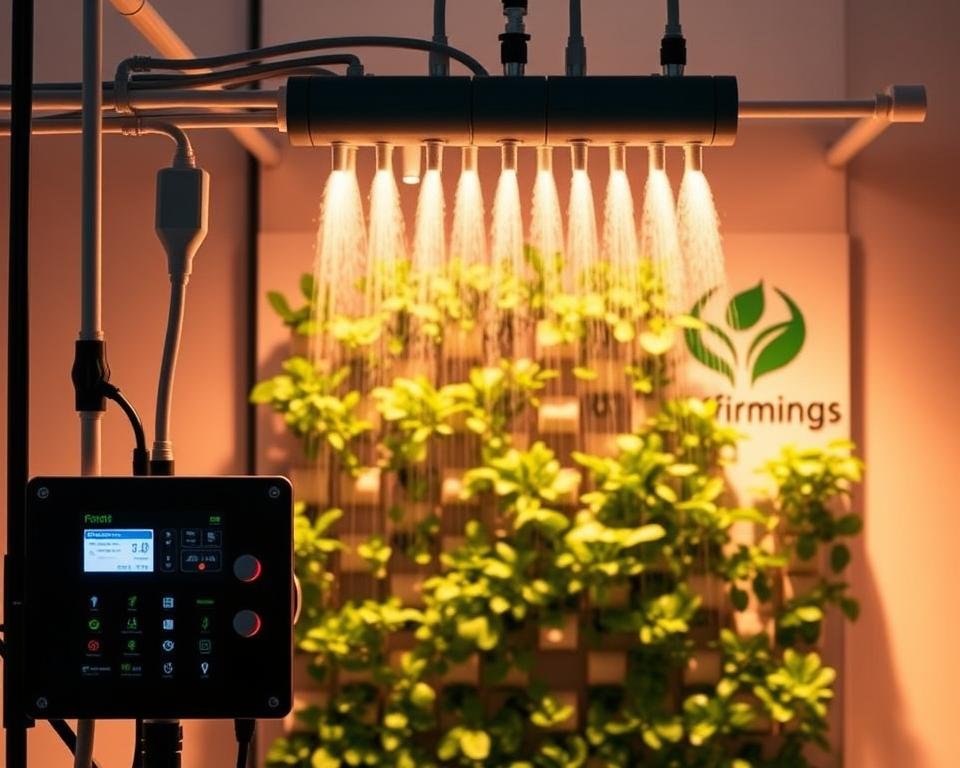
Smart watering technologies are changing urban gardening. These systems are more precise and efficient than old methods. They use advanced sensors and controls to save water and keep plants healthy with little effort.
Smart Watering Systems and Drainage Options
Your vertical garden can now use new irrigation technologies that save a lot of water. Key features include:
- Real-time moisture sensing
- Automated water distribution
- Precision drainage mechanisms
- Water recycling capabilities
Automated Nutrient Delivery Methods
Hydroponic systems are the best for nutrient management. They deliver nutrients directly to plant roots, promoting growth and reducing waste.
| Irrigation Method | Water Savings | Efficiency |
|---|---|---|
| Traditional Irrigation | 0% | Low |
| Drip Irrigation | 50% | High |
| Hydroponic Systems | 90% | Very High |
Monitoring and Control Technologies
IoT devices let you check your vertical garden from anywhere. These systems give real-time data on plant health, water, and nutrients.
By using these advanced technologies, you can make your vertical garden smart and efficient. It will adapt to your needs and grow well.
Sustainable Growing Methods and Materials
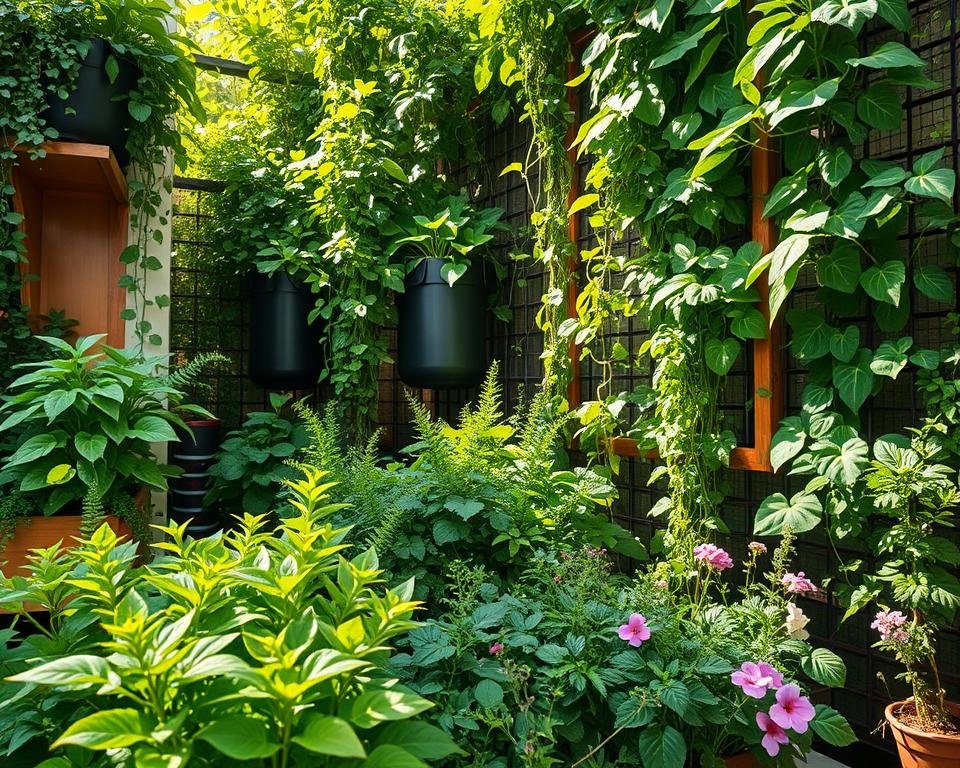
Vertical gardening is changing sustainable agriculture with new, flexible ways to grow. It lets you create green spaces that are good for the planet and use resources wisely.
Choosing the right materials is key in vertical garden design. Eco-friendly and recycled items are changing urban farming:
- Bamboo: A fast-growing, renewable resource
- Recycled plastic: Used for garden structures
- Cork: A green, versatile material
- Hempcrete: A building option that’s good for the environment
Water saving is important in vertical gardens. New methods like collecting rainwater and using it again help plants grow well without wasting water.
| Material | Sustainability Benefit | Growth Potential |
|---|---|---|
| Bamboo | Rapidly renewable | Up to 91 cm per day |
| Recycled Steel | Infinitely recyclable | No property degradation |
| Mycelium | Biodegradable | Organic waste transformation |
Using adaptable structures and green growing methods makes vertical gardens beautiful and eco-friendly. They help cities be greener and reduce harm to the environment.
Plant Selection and Growth Optimization
Vertical gardening turns small spaces into places where plants can thrive. Success comes from picking the right plants and using smart growing methods. These methods use scalable architecture and flexible manufacturing.
Picking the right plants is key for a successful vertical garden. Each plant has its own needs that affect how well it grows in tight spaces.
Best Plants for Vertical Garden Success
- Leafy Greens: Spinach, lettuce, kale
- Herbs: Basil, mint, cilantro
- Compact Vegetables: Cherry tomatoes, peppers, strawberries
Seasonal Planning and Rotation Strategies
Using a smart crop rotation keeps your garden productive all year. Plan your planting to ensure a steady harvest.
| Season | Recommended Crops | Growing Capacity |
|---|---|---|
| Spring | Lettuce, Spinach | 20 plants per m³ |
| Summer | Tomatoes, Peppers | 16 plants per m³ |
| Fall | Kale, Swiss Chard | 18 plants per m³ |
| Winter | Herbs, Microgreens | 22 plants per m³ |
Maximizing Yield in Limited Space
To get the most from your vertical garden, know what each module can do. Each unit can hold 4 plants and weigh up to 2.3 kg. Choosing the right plants and managing weight are crucial for efficiency.
Using advanced LED grow lights can help too. They give plants the right light for each stage of growth. This lets you grow plants longer and better in your vertical garden.
Conclusion
Modular vertical gardens are changing how we grow food in cities and our homes. They use smart designs to make gardening easier and more flexible. This lets you turn small spaces into lush, productive gardens.
These gardens are key to a greener future in cities. They help you grow your own food and enjoy green spaces. Plus, they’re easy to set up and change as you need.
Thanks to new tech, vertical gardens are now within reach for everyone. You can have a garden that takes care of itself with smart watering and feeding. They’re perfect for city balconies or homes looking to grow more.
Modular vertical gardens are leading the way in urban design. They’re not just for gardening; they’re a way of life. They blend efficiency, creativity, and caring for the planet. Start your urban gardening journey with these smart, adaptable systems.

